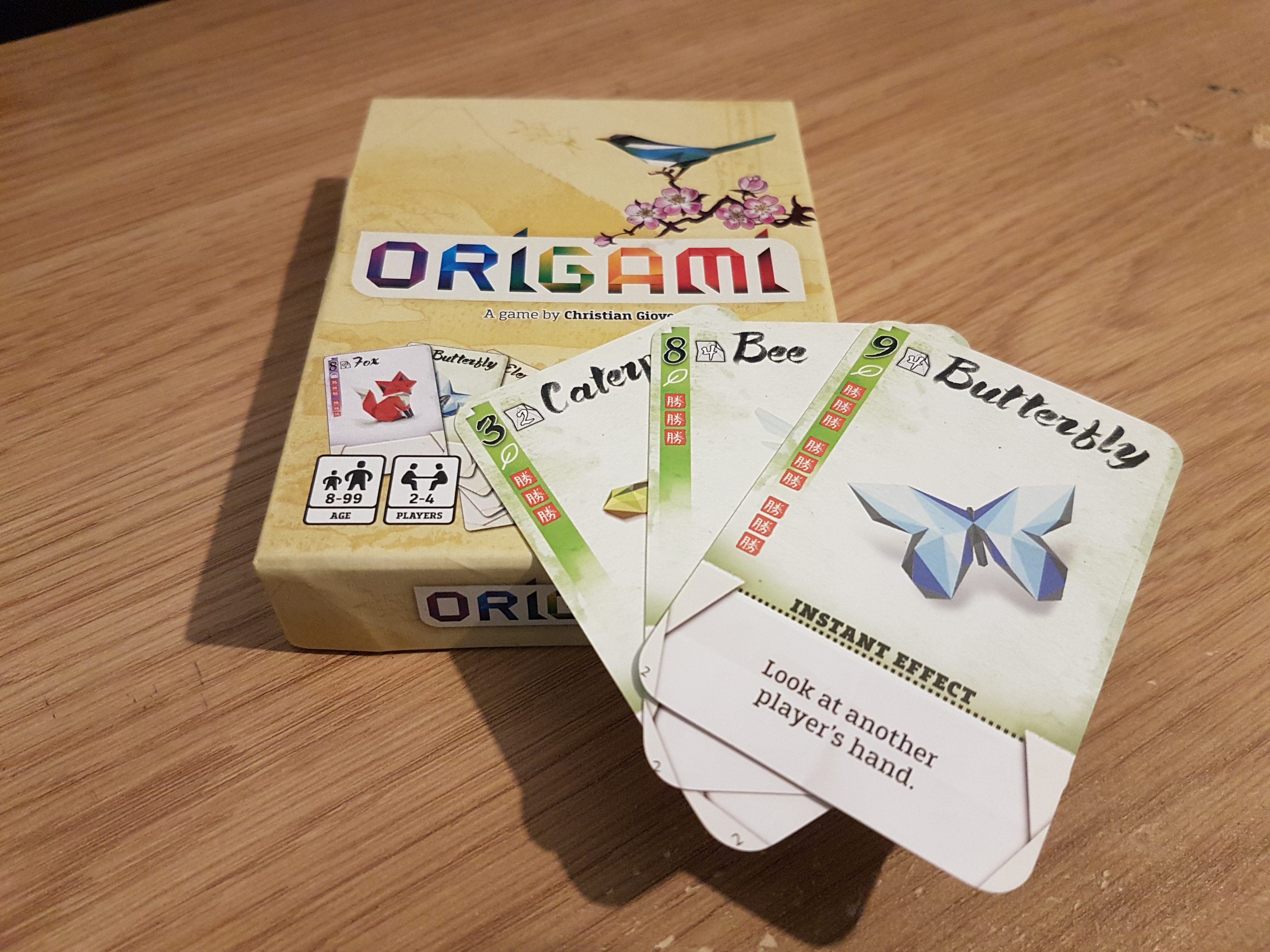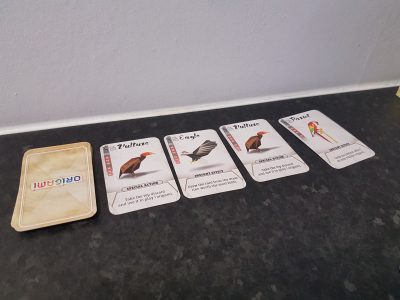Origami is a brand-new card game from designer Christian Giove and publisher dV Giochi. The game sees 2 – 4 players gaining and using cards depicting folded animals, to purchase cards, obtain abilities and score victory points. The game takes around 15 – 30 mins depending on the player count. Coming in a tiny box, does Origami pack in quality gameplay or is the gameplay as thin as folded paper? Let’s find out!
To start with it is best to describe the cards that will played with. Each card has five main gameplay elements: a fold amount, a cost to play, a set symbol (for ease sets are also colour coordinated), an amount of victory points the card is worth and an effect. The folds of a card are important for when drawing cards and spending them to play cards. The symbol sets allow players to distinguish the 5 card sets of the game and are used as icons to reduce the amount of text when it comes to origami effects.
Origami is not only a short game, it is extremely fast to get to the table. Before playing the deck must be constructed out of the five family sets. Simply select as many sets of cards as there are players and get shuffling. The top 4 cards of the deck are turned over to form a draw line. To set up the starting hands keep dealing each player cards until the number of folds of their cards are greater or equal to 10. This gives each player a variety of cards, normally around 4/5, to play with. For balance purposes the player with the least folds, after this process, starts the game off.
On a turn a player can do one of three potential actions. The first is always available to players, and it sees them drawing cards from the draw line up to the value of 4 folds. Note that this is the folds a card offers not the cost. The second action is to play a card from you hand. To do so you must discard cards with fold values totalling equal to the cost of the played card.
When a card is played that player can place it into one of two columns in front of them. To keep the balance between the columns they can never have a height difference greater than 1, so you will be covering cards as the game goes on. Each card has an effect regardless of what card family it is from, these are: Instant Effect, Scoring or Special Action. Unsurprisingly, special action is the third and final potential action a player can take. The exact action is denoted on cards and can be performed if the card is in play and still the top most card of a column.
The instant effects are the most common card effect: allowing players to do things such as drawing a card from the discard pile, draw deck or draw line. Not everything is aimed towards drawing cards though and some cards instead come with scoring abilities. The exact requirements for scoring are written on the cards but often relate to other cards. For example, the Chicken scores points for each played Chick. These can be extremely lucrative if opponents don’t snatch up the chick cards.
At the end of a player’s turn the draw line is filled back up to four cards from the draw pile, the next player takes a turn and so on. When the draw deck runs out for the first time the discard pile is shuffled and reforms the deck. The second time it is still reshuffled but this triggers the end of the game, with each player up to the starting player getting one last turn. This nicely enables everyone to have the exact same amount of turns during the game. Scores are calculated from the victory point symbols on cards and the scoring effects of any cards played, including those hidden in the columns. Whomever has the most points wins!
As hiding special action effects stop them from being usable it makes for an interesting decision when to do it. Losing that perk that has been helpful is a necessity though, as you need to continue to try to score more points by playing cards. As a group of cards there are not a great number of these special actions available in the card sets. This combined with the fact they get covered up, so a player never gets to use one for too long, helps balance what are otherwise rather strong actions. It is unlikely the player will not try to use the special action on their turn. This isn’t just out of being able to do something different but also to gain a little advantage.
Unlike many card games, Origami speeds up as you play. It would be expected that when you shuffle the deck for the first time, with the second shuffle triggering the end of the game, the game is at its mid-point. In fact, when this shuffle commences the mid-point of the game is already past. Throughout players are drawing cards to their hand, playing some down in front of them and then discarding the rest. This results in a smaller deck after shuffling than at the offset of the game, making the “second half” of the game go quicker.
Origami manages to scale up well with the player count. The decks start off larger but the amount of turns per player remains around the same. Downtime will naturally be increased as you wait for more players but the core of the game remains intact. One of the biggest changes are instant effects which target all opponents. An owl for instance has an instant effect that makes all players discard 1 card from their hand. This is beneficial in a 2-player game but has bigger effects, burning more cards, in a 4-player game.
Scoring cards encourage set collection, rather than aiming solely for individual high scoring origami cards. Ants can gain players huge points for being collected in pairs, making it almost feel like a waste if you have an odd number. While the Lawn card set, which included Ants, is more set collection orientated, the Savannah family is slightly more focused on discarding. This means players experience a different style game, with optimal strategies dynamically changing from game to game, simply by using different families of animals.
In 2-player games only two of the five family card sets are utilized. Each card set offers a different overall theme of animals and come with a unique set of abilities. This builds up a lot of potential combinations, building replayability into the game. Even at the full player count of 4 there are 5 different combinations, so the replayability doesn’t instantly drop away because of less variation. This should allow for some kind of longevity to playing Origami.
The cards tell players what to do: therefore, after learning the general actions and the fold currency you can jump in and start playing. The first game anyone play with a new card set will be slower as players study the new cards; as they gain them or they enter the draw line. This works for a first playthrough though as player start to learn what are good decisions. Naturally, the game speeds up overtime, as players start to know the abilities of the cards and potential combos.
Origami’s cards feature simplistic illustrations that perfectly fit the theme and name of the game. There has been a bit of a split among those I’ve played with in feelings towards this art style though most have loved it. Most react with warmth to the cute origami animals that feature on the cards but I can see why other suggest they are too simple with such limited details. This is somewhat of a resonating feature throughout Origami: it doesn’t shout out, it is understated and gets on with what it is a short, lightweight card game.
If a player suffers from analysis paralysis in other games it could become a problem in Origami. The gameplay thrives when the fast pace drawing and playing cards in maintained, otherwise it can at times feel like “just” picking up a card. Another aspect which slows the game down is the inability to overpay when playing cards. Players must have the exact denomination of folds from other cards. This leads to frustration when a bad run of available cards comes up and sees players start to horde cards. This gets away from the fun of actually playing cards and getting their benefits. To counter any hording of cards there is a hand limit of eight cards. This isn’t often reached but it is there to force players into eventually using cards.
It would have been nice to see some sort of special objectives to spice things up scoring wise. A brilliant example is how Dragon cards add a simple additional scoring rule in Dragon Castle. All it would take is a small deck of objective cards, with one being put in play each game, that gives points for say each set of each family type. This would result in the optimal decision changing from game to game if somehow the exact same cards became available. It isn’t necessary for the game to be enjoyable but I feel it could have helped increase the longevity of the title.
I’ve really enjoyed playing Origami to date and have yet got to perfectly understand the nuances and perfect combinations of cards, but that only drives me to play more. The replayability of this game is immense with a different order of cards in the deck making decisions change, let alone with different card sets being thrown into the mix. I have learned towards playing Origami as a 2-player game just to maximise the speed of play, as this is where it thrives. To make it all a sweeter deal the box is tiny, only the size of a standard double deck of playing cards, so it is super easy to transport. If you’re looking for a fast, lightweight card game with some lovely, cute artwork look no further than Origami.
[Editor’s Note: Origami was provided to us by dV Giochi for the review.]






Ossama Helmy
August 21, 2018 at 3:59 PMHello,
How i can buy this game in English? I’m from Egypt and im an origamist and I’ll be in Berlin soon .
Thank you